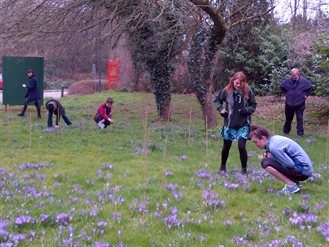The second annual Nottingham Crocus count has shown an increase in the numbers of this locally rare species on University Park campus.
The inaugural Nottingham crocus count, which was undertaken by volunteers and the University’s Ground Manager Desmond O’Grady, resulted in the group identifying three colonies of 8700 flowering spikes. This year’s volunteers, along with Desmond O’Grady and Alice Hallows from the Student Volunteer Centre, recognised and noted over 13500 flowering spikes on campus, which is an increase of 55% on the previous year.

The count was conducted over two days in late March and these results have now been passed on to the county recorder.
The counting is an essential part of a project to map and monitor the plant’s distribution. This increase in flower spikes may, in part, be due to the continual management of the extensive grounds by the University’s Grounds Team throughout the campus.
The Nottingham crocus (Crocus vernus) has a similar colour combination to the cultivated Crocus and can be hard to distinguish with the naked eye, however the Nottingham spring crocus has a ruffled edge to its petals.
Nottingham spring crocus used to be abundant in meadows alongside the River Trent, particularly in Wilford and Dunkirk, but is now rare and the subject of a species action plan by Nottinghamshire Biodiversity Action Group. Any further sightings of the Nottingham spring crocus (or its close relation, the Nottingham autumn crocus) can be reported to Nottinghamshire Wildlife Trust.
Posted on Tuesday 21st April 2015